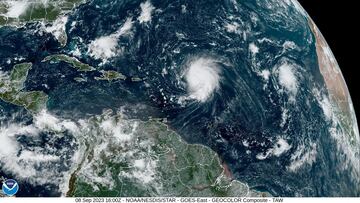How are hurricanes named and why do the names get retired?
The Atlantic hurricane season is in full swing and meteorologists predict it will be more active than usual with as many as 25 named storms in 2024.


The United States is in the middle of the 2024 Atlantic hurricane season, with parts of the country bracing for the arrival of potential Hurricane Helene. The National Oceanic and Atmospheric Administration (NOAA) and FEMA advise those likely to be affected to be vigilant and prepared should a monster storm hit your community. The weather agency is forecasting an 85% chance that this year, activity will above normal.
Meteorologists at NOAA are predicting as many as 25 named storms in 2024. Between four and seven could be classified as major hurricanes (category 3, 4 or 5). As with any season, these weather systems will all have a name waiting for them when they form.
READ ALSO: Potential Hurricane Helene approaches US: live updates
Do you know the difference between a Flood Watch vs. a Warning that is issued by the @NWS?
— NYS Div. of Homeland Security & Emergency Services (@NYSDHSES) September 20, 2024
👀 Watch: Stay alert! Conditions are favorable for flooding to occur.
⚠️Warning: Take action! Flooding is imminent or already happening.
For more safety tips: https://t.co/V9W86LnNmX pic.twitter.com/1BOOkX2mn0
When did NOAA begin naming storms?
In the mid-twentieth century, the U.S. government began naming storms to simplify communications and inform the public about them. Before, NOAA often used positions or latitude and longitude to communicate about storms but this becomes very confusing when there is more than one present in a specific area at a time.
A storm is given a name when its winds reach more than 39 miles per hour. The World Meteorological Organization, which selects the names, upgrades the storm to a hurricane or typhoon if sustained winds reach more than 74 miles per hour.
Neither the World Meteorological Organization nor NOAA invented this naming practice. In Puerto Rico records show that as early as 1876, before becoming a colony of the United States, some on the island would christen each storm with the name of a saint. A meteorologist in Australia also popularized the practice in the 19th century, which was adopted by the US in the 1950s.
READ ALSO: Spaghetti models used to track hurricanes
READ ALSO: Defining a hurricane
In the first few decades of using this method NOAA had only selected women’s names for storms. However, in the 1970s this practice was ended and traditionally male names were used. This did lead to a phenomenon noted by social scientists where storms with female names were thought of as weaker and less of a threat; highlighting the ways in which gender bias informs a society’s perception of a threat. It is important to remember that the severity of a storm has no influence over the name that is selected. Quite the opposite.
Related stories
Twenty-one storm names have already been chosen for each of the next six years, letters Q, U, X, Y and Z are not used. As the storms emerge they will be given a name in alphabetical order, and should there be more than twenty-one, the names will be taken from an alternate list approved by the WMO. The lists are recycled every six years.
What names have been retired?
NOAA has reported that “if a storm is so deadly or costly that the future use of its name on a different storm would be inappropriate for obvious reasons of sensitivity,” it can be retired. Since 2000, forty-four names have been taken out of circulation. This compares to twenty-two names retired between 1980 and 1999. This means that since the beginning of this century more than double the names have been retired than the previous two decades --an indicator of the impact of climate change on storm severity.


Complete your personal details to comment